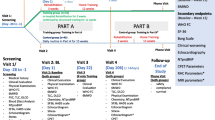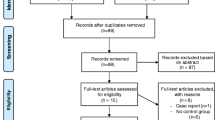Abstract
Objectives
To evaluate whether careful exercise training improves pulmonary perfusion and blood flow in patients with pulmonary hypertension (PH), as assessed by magnetic resonance imaging (MR).
Methods
Twenty patients with pulmonary arterial hypertension or inoperable chronic thromboembolic PH on stable medication were randomly assigned to control (n = 10) or training groups (n = 10). Training group patients received in-hospital exercise training; patients of the sedentary control group received conventional rehabilitation. Medication remained unchanged during the study period. Changes of 6-min walking distance (6MWD), MR pulmonary flow (peak velocity) and MR perfusion (pulmonary blood volume) were assessed from baseline to week 3.
Results
After 3 weeks of training, increases in mean 6MWD (P = 0.004) and mean MR flow peak velocity (P = 0.012) were significantly greater in the training group. Training group patients had significantly improved 6MWD (P = 0.008), MR flow (peak velocity −9.7 ± 8.6 cm/s, P = 0.007) and MR perfusion (pulmonary blood volume +2.2 ± 2.7 mL/100 mL, P = 0.017), whereas the control group showed no significant changes.
Conclusion
The study indicates that respiratory and physical exercise may improve pulmonary perfusion in patients with PH. Measurement of MR parameters of pulmonary perfusion might be an interesting new method to assess therapy effects in PH. The results of this initial study should be confirmed in a larger study group.
Key Points
• Quantification of magnetic resonance perfusion is feasible in patients with pulmonary hypertension.
• Quantified magnetic resonance perfusion may become useful for non-invasive monitoring of treatment.
• Quantification of lung perfusion allows new insights into lung (patho-)physiology of PH.
• Careful exercise training improves pulmonary perfusion and blood flow in patients with PH.


Similar content being viewed by others
Abbreviations
- 3D:
-
three dimensional
- MR:
-
magnetic resonance imaging
- MTT:
-
mean transit time
- PAH:
-
pulmonary arterial hypertension
- PBF:
-
pulmonary blood flow
- PBV:
-
pulmonary blood volume
- ROI:
-
region of interest
References
Galie N, Hoeper MM, Humbert M et al (2009) Guidelines for the diagnosis and treatment of pulmonary hypertension: The Task Force for the Diagnosis and Treatment of Pulmonary Hypertension of the European Society of Cardiology (ESC) and the European Respiratory Society (ERS), endorsed by the International Society of Heart and Lung Transplantation (ISHLT). Eur Heart J 30:2493–2537
McLaughlin VV, Badesch DB, Delcroix M et al (2009) End points and clinical trial design in pulmonary arterial hypertension. J Am Coll Cardiol 54:S97–S107
Galie N, Palazzini M, Manes A (2010) Pulmonary arterial hypertension: from the kingdom of the near-dead to multiple clinical trial meta-analyses. Eur Heart J 31:2080–2086
Kabitz HJ, Schwoerer A, Bremer HC et al (2008) Impairment of respiratory muscle function in pulmonary hypertension. Clin Sci (Lond) 114:165–171
Mereles D, Ehlken N, Kreuscher S et al (2006) Exercise and respiratory training improve exercise capacity and quality of life in patients with severe chronic pulmonary hypertension. Circulation 114:1482–1489
Grunig E, Ehlken N, Ghofrani A et al (2011) Effect of exercise and respiratory training on clinical progression and survival in patients with severe chronic pulmonary hypertension. Respiration 81:394–401
de Man FS, van Hees HW, Handoko ML et al (2011) Diaphragm muscle fiber weakness in pulmonary hypertension. Am J Respir Crit Care Med 183:1411–1418
Fink C, Puderbach M, Bock M et al (2004) Regional lung perfusion: assessment with partially parallel three-dimensional MR imaging. Radiology 231:175–184
Vonk-Noordegraaf A, van Wolferen SA, Marcus JT et al (2005) Noninvasive assessment and monitoring of the pulmonary circulation. Eur Respir J 25:758–766
Ley-Zaporozhan J, Ley S, Kauczor HU (2008) Morphological and functional imaging in COPD with CT and MRI: present and future. Eur Radiol 18:510–521
Ley S, Mereles D, Risse F et al (2007) Quantitative 3D pulmonary MR-perfusion in patients with pulmonary arterial hypertension: correlation with invasive pressure measurements. Eur J Radiol 61:251–255
Ohno Y, Hatabu H, Murase K et al (2007) Primary pulmonary hypertension: 3D dynamic perfusion MRI for quantitative analysis of regional pulmonary perfusion. AJR Am J Roentgenol 188:48–56
Ley S, Mereles D, Puderbach M et al (2007) Value of MR phase-contrast flow measurements for functional assessment of pulmonary arterial hypertension. Eur Radiol 17:1892–1897
McLure LE, Peacock AJ (2009) Cardiac magnetic resonance imaging for the assessment of the heart and pulmonary circulation in pulmonary hypertension. Eur Respir J 33:1454–1466
Sanz J, Kuschnir P, Rius T et al (2007) Pulmonary arterial hypertension: noninvasive detection with phase-contrast MR imaging. Radiology 243:70–79
Kreitner KF, Ley S, Kauczor HU et al (2004) Chronic thromboembolic pulmonary hypertension: pre- and postoperative assessment with breath-hold MR imaging techniques. Radiology 232:535–543
Guyatt GH, Pugsley SO, Sullivan MJ et al (1984) Effect of encouragement on walking test performance. Thorax 39:818–822
Fink C, Ley S, Kroeker R et al (2005) Time-resolved contrast-enhanced three-dimensional magnetic resonance angiography of the chest: combination of parallel imaging with view sharing (TREAT). Invest Radiol 40:40–48
Fink C, Ley S, Risse F et al (2005) Effect of inspiratory and expiratory breathhold on pulmonary perfusion: assessment by pulmonary perfusion magnetic resonance imaging. Invest Radiol 40:72–79
Meier P, Zierler KL (1954) On the theory of the indicator-dilution method for measurement of blood flow and volume. J Appl Physiol 6:731–744
Perthen JE, Calamante F, Gadian DG, Connelly A (2002) Is quantification of bolus tracking MRI reliable without deconvolution? Magn Reson Med 47:61–67
Berthezene Y, Croisille P, Wiart M et al (1999) Prospective comparison of MR lung perfusion and lung scintigraphy. J Magn Reson Imaging 9:61–68
Fink C, Bock M, Puderbach M, Schmähl A, Delorme S (2003) Partially parallel three-dimensional magnetic resonance imaging for the assessment of lung perfusion—initial results. Invest Radiol 38:482–488
Hatabu H, Tadamura E, Levin DL et al (1999) Quantitative assessment of pulmonary perfusion with dynamic contrast-enhanced MRI. Magn Reson Med 42:1033–1038
Ley-Zaporozhan J, Molinari F, Risse F, et al (2010) Repeatability and reproducibility of quantitative whole-lung perfusion MRI. J Thorac Imaging 26:230–239
Ley S, Puderbach M, Fink C et al (2005) Assessment of hemodynamic changes in the systemic and pulmonary arterial circulation in patients with cystic fibrosis using phase-contrast MRI. Eur Radiol 15:1575–1580
Coats AJ, Adamopoulos S, Radaelli A et al (1992) Controlled trial of physical training in chronic heart failure. Exercise performance, hemodynamics, ventilation, and autonomic function. Circulation 85:2119–2131
Drexler H, Riede U, Munzel T et al (1992) Alterations of skeletal muscle in chronic heart failure. Circulation 85:1751–1759
Piepoli MF, Davos C, Francis DP, Coats AJ (2004) Exercise training meta-analysis of trials in patients with chronic heart failure (ExTraMATCH). BMJ 328:189
Davies EJ, Moxham T, Rees K et al (2010) Exercise training for systolic heart failure: Cochrane systematic review and meta-analysis. Eur J Heart Fail 12:706–715
Hambrecht R, Niebauer J, Fiehn E et al (1995) Physical training in patients with stable chronic heart failure: effects on cardiorespiratory fitness and ultrastructural abnormalities of leg muscles. J Am Coll Cardiol 25:1239–1249
Ley S, Puderbach M, Risse F et al (2007) Impact of oxygen inhalation on the pulmonary circulation: assessment by magnetic resonance (MR)-perfusion and MR-flow measurements. Invest Radiol 42:283–290
Acknowledgments
This work was supported by the German National Research Agency (DFG): “Image-based V/Q analysis” (FOR 474-2). The authors are grateful to Mrs. Susanne Yubai and Mrs. Kathleen Knauer for excellent performance of the examinations. The authors want to thank all patients that participated in the study.
Author information
Authors and Affiliations
Corresponding author
Additional information
Hans Klose and Ekkehard Gruenig contributed equally.
This paper was awarded with the scientific presentation award “Chest” during the ECR 2008.
Rights and permissions
About this article
Cite this article
Ley, S., Fink, C., Risse, F. et al. Magnetic resonance imaging to assess the effect of exercise training on pulmonary perfusion and blood flow in patients with pulmonary hypertension. Eur Radiol 23, 324–331 (2013). https://doi.org/10.1007/s00330-012-2606-z
Received:
Revised:
Accepted:
Published:
Issue Date:
DOI: https://doi.org/10.1007/s00330-012-2606-z




